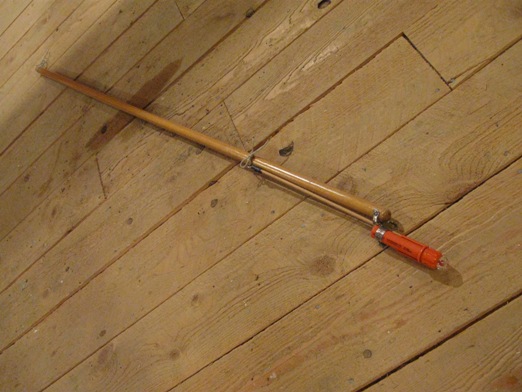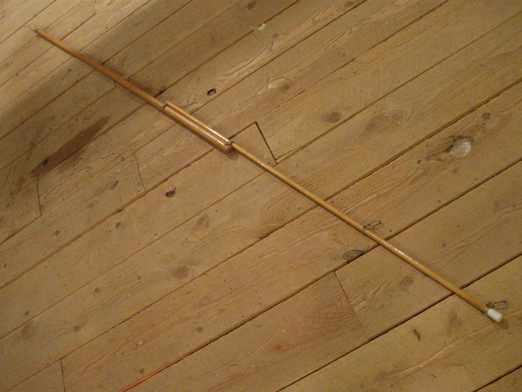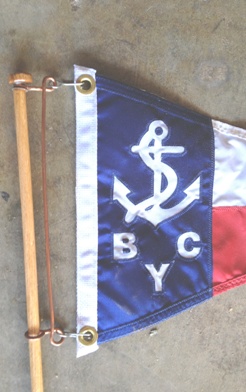|
At some point in the restoration/maintenance of small boats the issue of wiring in the mast comes up - the VHF radio whose range is affected by the antenna height, the masthead light for night cruising, dim visibility and anchoring, and foredeck lights for illumination on the foredeck for moving around up there at night.
As with all our Dolphin projects compromises have to be made. First a few inputs to the Marionette's decision making process.
1st - VHF Antenna - Installed a VHF cable with a fitting at the deck and another at the mast top to connect the antenna.. This is a big time safety issue
2nd - Forget the foredeck light. I'll use a flashlight if I ever have to go up there at night.
3rd - I rarely sail at night, maybe a few hours at most once in a while after dusk. In Maine fog you can't see the light - if the radar reflector doesn't work, I'm toast.
4th - Without an alternator, conserving the ship's single 105A battery's power is an important factor (July 16, 2013 Note - new battery upgraded to 200 amp capacity)
|
5th - I sometimes anchor in places that are not designated anchorages so a riding light is nice. I have a Den Haan oil anchor lamp to 'hang in my rigging'. Actually, I hang it off the forestay about 7-8' off the deck using the jib halyard and a line attached to the bottom ring and the main cleat on the foredeck. A full tank of oil burns for 40 hours. After all, our Dolphins are classic boats...
|
6th - US Coast Guard regs state that:
1. Sailboats under sail and under 40' can have a 135 degree stern light which Marionette has.
2. Sailboats under power and under 40' can have single all around light located at the stern or at the masthead.
3. Visibility - for sailboats all lights - 2 nautical miles except masthead, 3 nautical miles
|
I did not a) run 45' of duplex cable up the mast and through the boat, b) not add a separate switch at the panel, c) did not want the additional weight in the mast, d) did not want the additional rattle-in-mast potential, e) did not want the cost of the light itself (actually I already had 2 new versions in my spares box - but the principle applies) f) did not want to consume main battery power. |
This is Marionette's solution:

I bought an extra ACR personal life jacket light for about $10. It is waterproof, has at least an 8 hr battery life and a 2 mile visibility range (I know, I know, should be 3). I attached it to a 'light stick", and fit it to my masthead pig stick, normally used for a flag I might fly from the top of the mast - above the VHF antenna and the wind vane. This is a picture of it laying on the barn floor.

This is a close up picture of the light stick with the ACR light. It has an incandescent bulb and is powered by 2 AA Lithium batteries. It fastened to the light stick with a ss hose clamp. The stick slides through an eye strap and has a screw eye in the end. The pig stick has a small line that passes through a hole, is knotted off and which can be tied to the eye. The whole assembly is hoisted up on a flag halyard that runs through a small, fixed, cheek block at the top of the mast. I twist the top of the ACR light to turn it on.

This is the pig stick set up with the 'flag stick". Note the flag clips. It is longer so the flag/burgee will fly above the masthead wind vane and the VHF antenna. The base part of the pig stick is a simple wood handle for a pole brush. The flag and light sticks are smaller diameter wood dowels. Everything is varnished.
* Webmaster Note: Some readers may not be familiar with the term "pig stick". The following definition is from Wikipedia.
" A pig stick is a staff that carries a flag or pennant, usually the burgee of the boat owner's yacht club, above a mast of a sailboat, it's connected to a halyard so when it's raised the top of the mast, the "pig stick" extends above the mast allowing the flag to be seen flying above the boat's sails."

July 4, 2010 - Marionette dresses up w/pigstick flying club colors (picture added October 22, 2011)
***********************
February 16, 2009
Bridge Clearance
An important after thought - prompted by a recent inquiry from Scott Davies, Dorado, Yankee # 86, contemplating his upcoming passage beneath a 34' bridge in San Diego. NOTE: NOAA marine chart clearances are based on mean high water.
Mast lengths vary a bit between boats, and the mast step and mast tabernacles differ, so its important to measure the mast. As a guide here are Marionette's (O'Day #12) numbers:
mast length 29' 7"
waterline to cabin top 3' 5"
sub total 33'
radio antenna - 2 '10" (windvane 1'1")
Total 35'10"
We use 36' plus whatever safety factor I can 'afford'. The pigstick is on a halyard so it can be lowered. Other factors high/low tide, wakes, hard heeling, etc.
Webmaster Note August 12, 2014. Much if not most of the rest of the world is on the metric system and with the help of Kiwi and their crew, Tom and Helen Demarter, we are adding here the all important conversion factor - 1 meter (100 centimeters) equals 39.37 inches. Here's their email
Re: Thanks from Kiwi crew
We had rough waters and strong winds two days ago. The choice was to go offshore or take an inland passage with a 10 meter bridge. We looked online to see if the ten meter bridge was possible. Based on your calculations we reckoned our height was 990cm and slipped under the bridge safely!
Thanks,
Captain and first mate on Kiwi Tom and Helen
**********************
June 27, 2014. Jerry Slaugher, ROWDY, #5, sent in the following emails (edited) and photos of his new pigstick.
Hi Ron,
I have been meaning to send you a few pictures of my pig stick but hard boat labor kept getting in the way. The pig stick is made up of a couple of dowels, off hand I can't remember the sizes but the top one was a little smaller diameter than the bottom. I got some copper ground wire and bent it into the shape shown in the photo and mounted the wire on the upper dowel so it could freely rotate around the dowel. Then connected the upper and lower dowels with screw eyes, added a couple screw eyes for the flag halyard and there you have it. I may make a taller upper dowel if this set up fouls on the vhf antenna. We will see.
Jerry
|

Question - is this setup going to accommodate a battery powered masthead light?
Answer - possibly, but ROWDY already has a 12v wired masthead light
*************
|
|
This page is part of a series on electrical stuff, batteries, wiring, lights, etc. See Technical/Electrical
*******************************************************
December 22, 2017. Hal Schmelzer (Sunrisa, Yankee #168) contributes the following re his masthead bracket and anchor light (minor edits)
Hi Ron.
When I got her Dolphin #168 had an anchor light that was full of water. While I had the mast down I built and installed a custom bracket that fit over the top of the mast head and had room for a wind vane and a new led anchor light.
I did not leave room for a VHF antenna as I use a hand held here on the rivers. If I decide to add a bigger VHF unit I will use a deck mount. There are holes for it in the rear deck and a new mount was in the spares box.
Regards.
Hal
|
|

***************************
|
